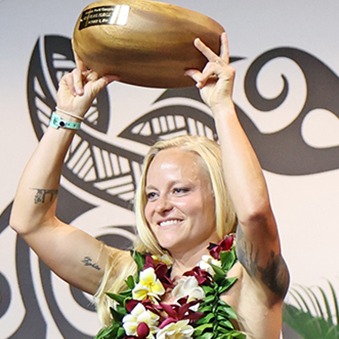
Samantha Skold
IRONMAN® World Championship
Samantha's headline numbers
Samantha's strategy
Fueling
Carbohydrate is the main fuel you burn when racing. Failing to fuel properly is a leading cause of underperformance in longer races.
Samantha impressively averaged ~29g of carbohydrate per hour more than during her 6th place age-group finish at the World Championship in Hawaii in 2023, helping to fuel her to an overall age-group win in 2025. She used a similar combination of products on the bike to previous races, including PF Carb & Electrolyte Drink Mix, PH 1000 (Drink Mix), PF 90 Gels, PF 30 Caffeine Gels but this time incorporated some PF Carb Only Drink Mix into each of her six litre bike bottles to up her carb intake. Then on the run, she had two flasks containing overconcentrated PH 1500 (Drink Mix), again, to deliver more liquid carbs alongside two PF 90 Gels. Although this was a mixture and volume she had tested in training, Samantha drank more fluid than she had before, and consequently her bike carb intake crept up as a result to over 120g/h. She went on to experience and push through some bloating and GI distress across the marathon. Although this was subjectively because of her hydration, given the extreme conditions in Hawaii, she may have benefited from decoupling her fuel from her hydration, by relying on her fluids for electrolytes and using gels and more solid fuel sources for carbohydrates. This would adjust her ‘hydration lever’ independently and drink more as required in the hot conditions, without overloading the gut ahead of the run.
Hydration
Taking on board an appropriate amount of fluid and sodium is essential to maintaining blood volume and supporting the cardiovascular effort needed to perform on race day.
Whilst the absolute amount of sodium and fluid consumed per hour is important, it’s critical to consider these in relation to each other. This is known as 'relative sodium concentration' and it’s expressed in milligrams per litre (mg/L). How much sodium you’re taking in per litre of fluid is more important than the absolute amount taken in per hour.
Sweat sodium concentration (mg/L) is largely genetically determined and remains relatively stable. Knowing how salty your sweat is enables you to replace a good proportion of your sweat losses, which can range from 200-2,000mg/L.
Whilst Samantha’s losses are on the moderate side, getting her hydration strategy right is still crucial when it’s hot and/or humid as her higher sweat rate in these conditions can result in significant net losses over the duration of a race.
Learn moreAfter her podium-topping performance, Samantha unfortunately ended up in the medical tent, which showed she finished the race ~1lb / 0.45kg heavier than when she started, which puts her at an increased risk of hyponatremia. In agreement with this data, Samantha mentioned she drank a lot more fluid on the bike than in her training rides, usually taking on up to a litre per hour compared to over 1.2L/h here (which was even closer to 1.5L in the first hour on the bike). It was likely she was replacing more than the volume she was losing at times across the 5-hour bike leg, and likely led to her bloating, cramping and stomach discomfort from the start of the run. Collecting more condition-specific sweat rate data would’ve helped give Samantha guidelines on how much she should be drinking to avoid over-doing it. Despite this, a flexible approach on the run and replacing her sodium losses consistently at ~1000mg/L allowed her to manage her symptoms, keep moving and maintain her lead to the finish.
Caffeine
Beyond the Three Levers of Performance (carb, sodium and fluid), caffeine is one of only a few substances that is proven to improve performance for most endurance athletes as it can help stave off mental and physical fatigue.
Taking on three PF 30 Caffeine Gels across the race, one before the swim, one halfway on the bike and one just out of T2, put Samantha right in the recommended range to enhance endurance performance. As well as being a dose that she has practised many times in training, keeping below 6mg/kg reduced the risk of negative side effects from the stimulant, including potentially impaired thermoregulation in such hot races.
How Samantha hit her numbers
Here's everything that Samantha ate and drank on the day...
Samantha's weapons of choice
Final thoughts
Samantha's full stats
Data Confidence?
There is an adequate level of accuracy in the data collected and the numbers reported. The athlete manages to recall what they ate and drank including most specifics (brands flavours quantities plausible estimations of volumes). However there are estimations made within the data which affect the overall confidence level in the data reported.